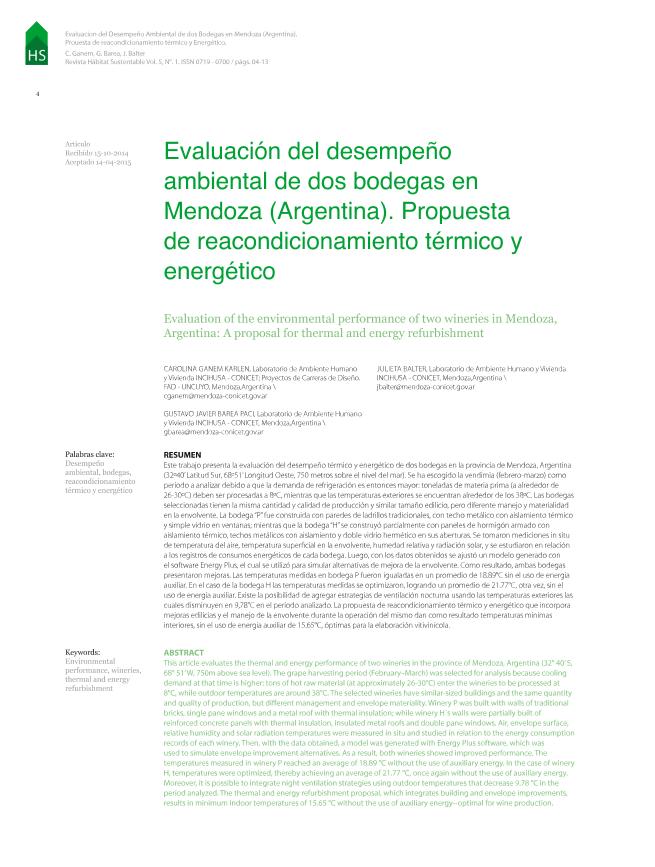Mostrar el registro sencillo del ítem
dc.contributor.author
Ganem, Carolina

dc.contributor.author
Balter, Julieta

dc.contributor.author
Barea Paci, Gustavo Javier

dc.date.available
2018-03-22T18:36:19Z
dc.date.issued
2015-04
dc.identifier.citation
Ganem, Carolina; Balter, Julieta; Barea Paci, Gustavo Javier; Evaluación del desempeño ambiental de dos bodegas en Mendoza (Argentina): Propuesta de reacondicionamiento térmico y energético; Universidad del Bío-Bío; Hábitat Sustentable; 5; 1; 4-2015; 4-13
dc.identifier.issn
0719-0700
dc.identifier.uri
http://hdl.handle.net/11336/39716
dc.description.abstract
Este trabajo presenta la evaluación del desempeño térmico y energético de dos bodegas en la provincia de Mendoza, Argentina (32º40’ Latitud Sur, 68º51’ Longitud Oeste, 750 metros sobre el nivel del mar). Se ha escogido la vendimia (febrero-marzo) como período a analizar debido a que la demanda de refrigeración es entonces mayor: toneladas de materia prima (a alrededor de 26-30ºC) deben ser procesadas a 8ºC, mientras que las temperaturas exteriores se encuentran alrededor de los 38ºC. Las bodegas seleccionadas tienen la misma cantidad y calidad de producción y similar tamaño edilicio, pero diferente manejo y materialidad en la envolvente. La bodega “P” fue construida con paredes de ladrillos tradicionales, con techo metálico con aislamiento térmico y simple vidrio en ventanas; mientras que la bodega “H” se construyó parcialmente con paneles de hormigón armado con aislamiento térmico, techos metálicos con aislamiento y doble vidrio hermético en sus aberturas. Se tomaron mediciones in situ de temperatura del aire, temperatura superficial en la envolvente, humedad relativa y radiación solar, y se estudiaron en relación a los registros de consumos energéticos de cada bodega. Luego, con los datos obtenidos se ajustó un modelo generado con el software Energy Plus, el cual se utilizó para simular alternativas de mejora de la envolvente. Como resultado, ambas bodegas presentaron mejoras. Las temperaturas medidas en bodega P fueron igualadas en un promedio de 18.89°C sin el uso de energía auxiliar. En el caso de la bodega H las temperaturas medidas se optimizaron, logrando un promedio de 21.77°C, otra vez, sin el uso de energía auxiliar. Existe la posibilidad de agregar estrategias de ventilación nocturna usando las temperaturas exteriores las cuales disminuyen en 9,78°C en el período analizado. La propuesta de reacondicionamiento térmico y energético que incorpora mejoras edilicias y el manejo de la envolvente durante la operación del mismo dan como resultado temperaturas mínimas interiores, sin el uso de energía auxiliar de 15.65°C, óptimas para la elaboración vitivinícola.
dc.description.abstract
This article evaluates the thermal and energy performance of two wineries in the province of Mendoza, Argentina (32° 40’ S, 68° 51’ W, 750m above sea level). The grape harvesting period (February–March) was selected for analysis because cooling demand at that time is higher: tons of hot raw material (at approximately 26-30°C) enter the wineries to be processed at 8°C, while outdoor temperatures are around 38°C. The selected wineries have similar-sized buildings and the same quantity and quality of production, but different management and envelope materiality. Winery P was built with walls of traditional bricks, single pane windows and a metal roof with thermal insulation; while winery H´s walls were partially built of reinforced concrete panels with thermal insulation, insulated metal roofs and double pane windows. Air, envelope surface, relative humidity and solar radiation temperatures were measured in situ and studied in relation to the energy consumption records of each winery. Then, with the data obtained, a model was generated with Energy Plus software, which was used to simulate envelope improvement alternatives. As a result, both wineries showed improved performance. The temperatures measured in winery P reached an average of 18.89 °C without the use of auxiliary energy. In the case of winery H, temperatures were optimized, thereby achieving an average of 21.77 °C, once again without the use of auxiliary energy. Moreover, it is possible to integrate night ventilation strategies using outdoor temperatures that decrease 9.78 °C in the period analyzed. The thermal and energy refurbishment proposal, which integrates building and envelope improvements, results in minimum indoor temperatures of 15.65 °C without the use of auxiliary energy--optimal for wine production.
dc.format
application/pdf
dc.language.iso
spa
dc.publisher
Universidad del Bío-Bío

dc.rights
info:eu-repo/semantics/openAccess
dc.rights.uri
https://creativecommons.org/licenses/by/2.5/ar/
dc.subject
Desempeño Ambiental
dc.subject
Bodegas
dc.subject
Reacondicionamiento Térmico y Energético
dc.subject.classification
Ingeniería Medioambiental y Geológica, Geotécnicas

dc.subject.classification
Ingeniería del Medio Ambiente

dc.subject.classification
INGENIERÍAS Y TECNOLOGÍAS

dc.title
Evaluación del desempeño ambiental de dos bodegas en Mendoza (Argentina): Propuesta de reacondicionamiento térmico y energético
dc.title
Evaluation of the environmental performance of two wineries in Mendoza, Argentina: A proposal for thermal and energy refurbishment
dc.type
info:eu-repo/semantics/article
dc.type
info:ar-repo/semantics/artículo
dc.type
info:eu-repo/semantics/publishedVersion
dc.date.updated
2018-03-21T16:30:22Z
dc.journal.volume
5
dc.journal.number
1
dc.journal.pagination
4-13
dc.journal.pais
Chile

dc.journal.ciudad
Concepción
dc.description.fil
Fil: Ganem, Carolina. Consejo Nacional de Investigaciones Científicas y Técnicas. Centro Científico Tecnológico Conicet - Mendoza. Instituto de Ciencias Humanas, Sociales y Ambientales; Argentina
dc.description.fil
Fil: Balter, Julieta. Consejo Nacional de Investigaciones Científicas y Técnicas. Centro Científico Tecnológico Conicet - Mendoza. Instituto de Ciencias Humanas, Sociales y Ambientales; Argentina
dc.description.fil
Fil: Barea Paci, Gustavo Javier. Consejo Nacional de Investigaciones Científicas y Técnicas. Centro Científico Tecnológico Conicet - Mendoza. Instituto de Ciencias Humanas, Sociales y Ambientales; Argentina
dc.journal.title
Hábitat Sustentable
dc.relation.alternativeid
info:eu-repo/semantics/altIdentifier/url/http://revistas.ubiobio.cl/index.php/RHS/article/view/1808
Archivos asociados
